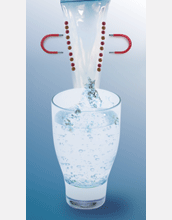Multimedia Gallery
Nanorust and Arsenic (Image 3)
Nanorust and Arsenic (Image 3)
By applying an external magnetic field gradient (the red horseshoe magnets shown in the image), it is possible to pull the nanoparticles out of the solution, thus removing the bound rust from the water. The aggregation of the nanorust is believed to be due to a cooperative effect between the nanoparticles, once the external field gradient is present. If the field is removed, the particles can go back into the solution reversibly.
More about this Image
The discovery of unexpected magnetic interactions between nanoparticles of rust was made by researchers from Rice University's Center for Biological and Environmental Nanotechnology (CBEN). The discovery could lead to a revolutionary, low-cost technology for cleaning arsenic from drinking water. Arsenic is a colorless, odorless, tasteless element that can lead to skin discoloration, sickness, cancer and death.
This image depicts how the particles bind with arsenic in water. The particles of arsenic-laden rust are then drawn out of the water by handheld magnets, leaving clean drinking water.
Arsenic-poisoned drinking water is a problem worldwide, and it is acute in the developing world. In Southeast Asia, 65 million people are at risk for arsenic-related health problems due to contaminated drinking water, this according to 2005 World Bank statistics.
Many rural communities in Southeast Asia rely on shallow underground "tube wells." The wells were installed in the 1970s to reduce dependence on bacteria-infested waterways and ponds, but many of the wells have turned out to be a source of naturally-occurring arsenic.
CBEN's purification technology is simple and requires no electricity, which many of these communities lack. The nanoparticles used in the CBEN experiments were expensive, so Rice researchers are working to develop less-costly production methods that will use household rust and olive oil, and will require no more facilities than a kitchen with a gas cook-top. (Date of Image: 2006) [Image 3 of 3 related images. Back to Image 1.]
Credit: Rice University Public Affairs/News and Media Relations
Images and other media in the National Science Foundation Multimedia Gallery are available for use in print and electronic material by NSF employees, members of the media, university staff, teachers and the general public. All media in the gallery are intended for personal, educational and nonprofit/non-commercial use only.
Images credited to the National Science Foundation, a federal agency, are in the public domain. The images were created by employees of the United States Government as part of their official duties or prepared by contractors as "works for hire" for NSF. You may freely use NSF-credited images and, at your discretion, credit NSF with a "Courtesy: National Science Foundation" notation.
Additional information about general usage can be found in Conditions.
Also Available:
Download the high-resolution TIF version of the image. (24.3 MB)
Use your mouse to right-click (Mac users may need to Ctrl-click) the link above and choose the option that will save the file or target to your computer.

